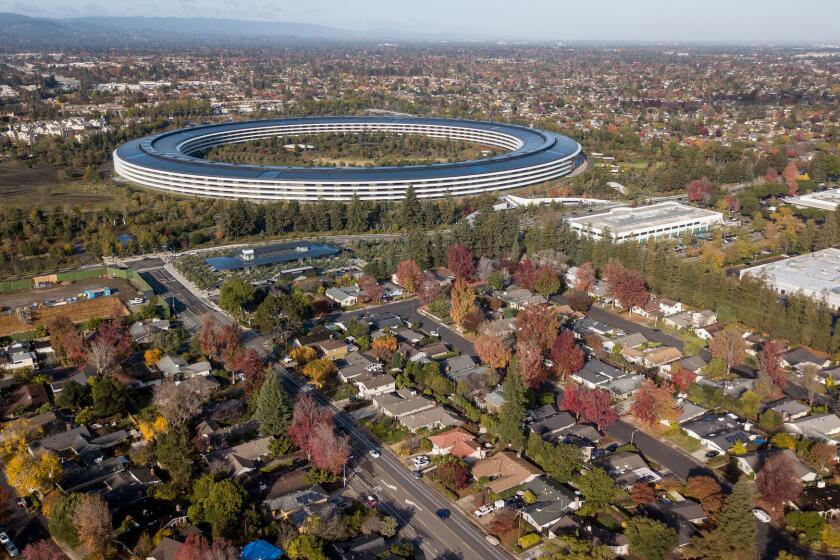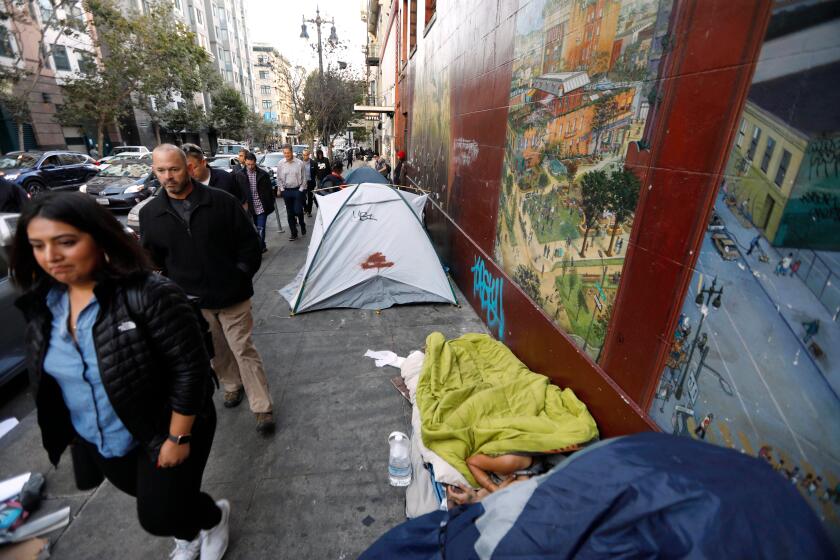The days of fast growth are ending for L.A. and California, report says
- Share via
It wasn’t so long ago that economic growth in California and Los Angeles far surpassed that of the nation.
Those days are coming to an end, according to the Los Angeles County Economic Development Corp., a nonprofit group that works with local businesses.
In 2018, while the U.S. economy expanded by 2.9%, California’s grew by 4.3% and Los Angeles County’s by 3.7%. In 2019, economic growth slowed to 2.3% in the U.S., 2.6% in California and 1.6% in L.A. County.
This year, California’s growth will slow to 2%, and L.A. County’s economy will expand by just 1.8% — close to the nation’s 1.9%, the LAEDC predicted Wednesday in its annual forecast, presented to business executives and government officials at the Sheraton Grand Hotel in downtown Los Angeles.
“This represents a marked slowdown,” the report noted, citing grim state and local statistics on housing affordability and stagnant population growth, along with uncertainty over President Trump’s continuing trade war. Last February, LAEDC had predicted far faster growth — 3% for California and 2.7% for Los Angeles in 2020.
This year, LAEDC economists threw cold water on Trump’s frequent assertions that the U.S. economy, in the wake of corporate tax cuts, would expand by more than 3% a year. They predicted GDP growth would slow to 1.7% next year.
“Though this leaves less breathing room between an expanding economy and a contracting one, a recession in 2020, predicted by many in 2018, or even in 2021 is not preordained,” the report said.
California lost more manufacturing jobs to China than any other state.
The assessment is in line with other forecasts. “Though the pace of real GDP growth has slowed this year, there are few signs that the longest U.S. expansion is on its last legs,” the Federal Reserve Bank of St. Louis reported in November. “The consensus of professional forecasters is that real GDP growth will dip below 2% in 2020.”
The LAEDC noted that “notwithstanding its intent, the trade spat with China has not improved the trade balance,” and it emphasized what it called “an eventual demographic time bomb as the population continues to age beyond prime productivity.”
The demographic effect: “In 2019, the addition of new prime age workers, meaning those from age 25 to 54, slowed despite the economy expanding. This will likely worsen if Millennials and Generation Z continue the trend of family sizes below replacement level.”
The report compared the Golden State’s trajectory with that of other states. “In 2014 and 2015, California was the fastest growing state in the union by real gross state product,” it noted. “As of the third quarter of 2019, California appears more susceptible to the national slowdown relative to other states, ranking only 23rd in terms of quarterly growth.”
California’s unemployment rate should drop from 4.1% last year to 3.9% by the end of 2021, the LAEDC predicted. The 3.9% rate would be the same as in the last quarter of 2019, and the lowest since 1976, when the state changed its statistical methodology.
The tightening of the labor market, according to LAEDC, will drive real personal income increases of roughly 2.2% in both 2020 and 2021.
Statewide, the health sector, along with professional and business services, will account for much of the job growth, the report said. Technology will continue to drive the San Francisco Bay Area economy. In L.A. County, construction will boost employment as major transportation projects get underway, including Metrolink’s decade-long, $10-billion overhaul of its passenger and freight rail network.
Transit expansion and development are being rushed in anticipation of the 2028 Olympics, but LAEDC suggested “there will likely be greater demand for workers than can be met, especially in the short-term.”
Wage inequality has risen more in California cities than in the metropolitan areas of any other state, with seven of the nation’s 15 most unequal cities located in the Golden State.
For California, as for the nation, demographics present a significant challenge. The state’s population grew by less than half a percent last year. “Prior to the 2008 financial crisis, California had a total fertility rate well above the national average, and often above the replacement level fertility rate of 2.1 [births per woman], causing increases in population apart from migration,” the LAEDC said.
“The population is rapidly aging, which also reduces economic growth as the share of prime working age population declines.”
Traditionally, immigration has compensated for a slow out-migration of native Californians. But Trump’s crackdown on immigrants and refugees has affected the state. “With an uncertain immigration policy environment emanating from Washington, immigration has not provided this supplement,” the report noted.
A housing shortage is driving high costs and “should be grounds for grave concern regarding sustainable economic growth,“ the LAEDC said.
“In 2018, the median home in California was 7.3 times the median household income, in contrast to the median home in the United States, which was only 3.7 times the median household income…. Current construction trends mean this pattern is unlikely to abate in the near future.”
The forecast suggested California housing permits will fall from 107,433 in 2019 to roughly 92,000 in 2021. In L.A., where officials say 60,000 new housing units a year are needed, LAEDC forecast 21,000 permits a year for 2020 and 2021.
“This means that housing costs are likely to stay high in the near term, driving continued out-migration to the Inland Empire, as well as to more affordable states.”
L.A. County is home to one-fourth of Californians and produces more than one-fourth of its state’s gross product, the report noted. It predicts L.A. County growth will slow to 1.6% next year.
The county’s jobless rate “sits a full point above the nation at 4.5%, but the situation is significantly worse when examining U-6 (unemployment) rate,” a supplementary federal statistic that includes marginally attached and part-time workers who want to be full time, LAEDC said. “This underemployment rate has remained over 10% for the last several years, stubbornly high despite broadly improving economic conditions.”
In California, that underemployment rate averaged 8.5% last year, and it was 7% nationally.
The LAEDC added, “This is an important risk to the regional economy since reducing labor market slack is key to driving wage growth, and the greater looseness in the Los Angeles County labor market means that wages are not going to rise as rapidly as they might otherwise.”
More to Read
Inside the business of entertainment
The Wide Shot brings you news, analysis and insights on everything from streaming wars to production — and what it all means for the future.
You may occasionally receive promotional content from the Los Angeles Times.













